The Episode
Personally, I never really played much of Castlevania II when I was a kid; from what I saw in Nintendo Power, those weird VHS tapes with game hints, and at friends’ houses, the game just felt “empty”. The invisible stuff everywhere probably didn’t help matters.
It wasn’t until much later that I gave the game a shot and gained a new appreciation for it. I partly wonder if that’s because of the Nerd’s videos about it, or if it’s because I’m older now. Maybe both.
You know, now that I think about it, I bet the Nerd’s introduced more people to Castlevania II than anyone on the planet.
A Look at the Game
First, let’s take a quick look at the Japanese release and the North American release.
The game was originally released for the Japanese Famicom Disk System, so the Japanese game came as a disk rather than a cartridge. The disk format meant that the player’s progress could be saved, and it also allowed for some more advanced sound and music. When the game was released in English it had to be ported to standard cartridge systems, which meant some of this content had to be changed.
 | 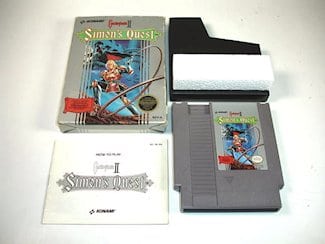 |
| Dracula II (FDS) | Castlevania II (NES) |
The Japanese title translates to something like, “Dracula II: The Cursed Seal”. This is kind of strange, as the game before it wasn’t simply called “Dracula”, and the game that came after it wasn’t called “Dracula III”. In fact, the whole series in Japan has had a really insane naming scheme that would make the Nerd’s “Chronologically Confused” episode explode.
Booting Up
The Nerd rants quite a bit on how slow and tedious parts of Castlevania II are – but the truth is that it could’ve been a lot worse.
For example, in the English version of the game, when you turn on the NES you’re taken immediately to the title screen and you can start playing a new game in just a second or two. In the Japanese version, though, you have to load the disk into the system, hope you remembered to insert the right side up, wait for a few screens to pop up, go through the title screen, go through name entry screen, go through the save load screen, then eject the disk and re-insert it upside-down.
Whew!
Oh, and then you have still to wait through two more loading screens.
Of course, it’s not REALLY as bad as it sounds, but the instant load times of the cartridge format was a big benefit that most NES gamers probably never knew about.
Famicom disks were also prone to errors – the actual data disk part was literally exposed to the air, so kids could easily scratch the disks, bend them, mess them up or whatever. I’ve even heard of stories of Famicom disks somehow getting moldy. So if you weren’t careful, you could end up with an unplayable game.
 |
So I guess that’s yet another side benefit the NES version had over the original – the NES cartridges were actually, physically sturdier and weren’t at risk of becoming useless.
Man, looking back, I guess I didn’t realize how spoiled I was as an American gamer.
Title Screen
Since the game titles are different, it makes sense that the title screens are different too. The Japanese release not only has some spooky bats, but it has some animated blood that drips down from the text.
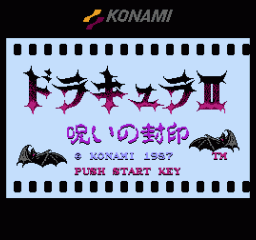 | 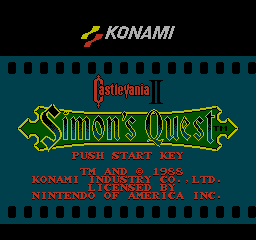 |
| Dracula II (FDS) | Castlevania II (NES) |
The game’s intro is in English in both versions of the game. Why would the Japanese version have the story written in English, you ask? Well, it was pretty common for the time, plus there’s a bunch of other cultural and technical reasons.
 | 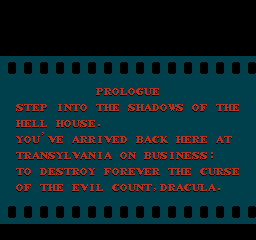 |
| Dracula II (FDS) | Castlevania II (NES) |
PROLOGUE
Step into the shadows of the Hell House.
You’ve arrived back here at Transylvania on business: to destroy forever the curse of the evil count, Dracula.
More than anything, though, I’m surprised that the word “hell” made it into the English release. But looking back it probably shouldn’t be too surprising – after all, Nintendo publicized the game in its official American magazine with THIS:
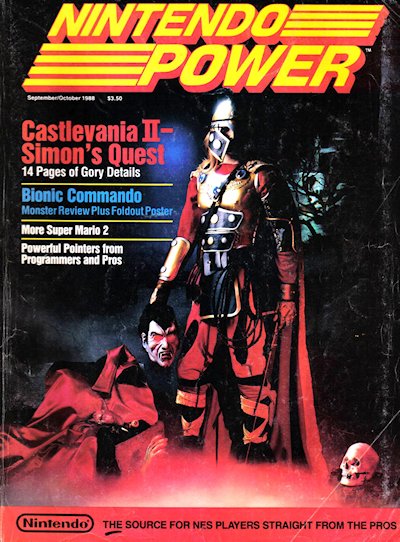 |
Yikes. I remember being freaked out by this as a kid.
Saving the Game
Since the Japanese game uses a rewritable disk, the game can save the player’s progress to a save file. This is pretty handy and makes playing through the game a little less tedious. The Japanese save screen also conveniently displays how many days have passed in-game.
The English version came on a plain cartridge without any battery-backed save capabilities, so an all-new password system was be implemented so players could still record their progress in some way.
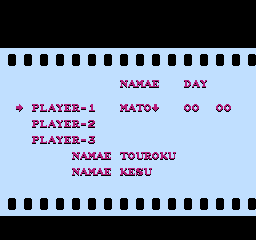 | 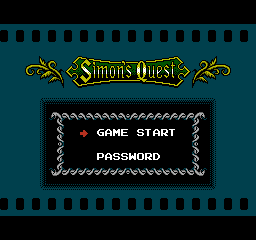 |
| Dracula II (FDS) | Castlevania II (NES) |
In other words, Japanese players never had to spend all that time fighting the sluggish, annoying password system with Os look like 0s, ls that look like Is or 1s, etc. This was an added pain only players outside of Japan had to endure.
Not that it helps ease the pain, but the password input screen DOES look pretty cool, and the actual input method is much nicer than the input method used to name your save files in the Japanese version.
 |
Even though the English password system leaves a lot to be desired, there IS a silver lining to it – you can easily jump to almost any point in the game. So if you want to rush straight to the end of the game, you can. Want to skip an annoying part of the game? You can. If you want to have certain equipment, you can. You just need a list of passwords. Back in the day, this meant swapping codes with friends at school, checking Nintendo Power, or just through your own hard work.
With the Japanese version, though, there’s no jumping straight to any point. If you wanna show a friend a certain part or if you want to skip an annoying part, too bad. You gotta slog your way through the game the hard way. As a result, the added convenience and offline interaction of the NES release isn’t a part of the Japanese version’s experience.
So I guess in a weird, unexpected way, the dreaded password system has its pluses and minuses.
What a Horrible Night to Have a Disk
The Nerd’s anger explodes when he brings up the whole part about the “What a horrible night to have a curse” message that pops up every so often and pauses the game for an annoying amount of time.
This got me thinking, “I wonder if it’s so long and annoying in the Japanese version.” So I checked it out and made a video.
Indeed, it looks like the Japanese message is shorter and ends sooner than in the English version. It’s still a bit annoying, but the Japanese version definitely has the upper hand this time around.
Also of interest is that the Japanese version makes no mention of a curse at all. It actually says something more like, “And then fell a ghastly night.”
I was also curious about the other pop-up message when the sun comes up:
This Japanese message is definitely a lot shorter than the English version. It’s still sort of annoying, but I think Japanese Nerd wouldn’t have had as much to rant about. For reference, the Japanese line here is something like, “The nightmarish night gave way to dawn.”
Still, even though these pop-up messages might be annoying and slow the game down a bit, it’s NOTHING compared to what Japanese gamers had to endure – just taking a single step outside of the first town can be soul-crushingly aggravating.
And if you think THAT’S bad, there are some places where getting knocked into another screen means you have to eject and reinsert the disk upside down, on top of the normal load times.
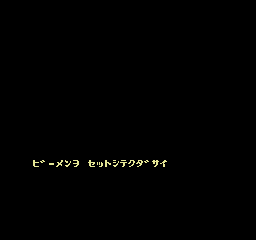
This effectively means you have to eject and reinsert the disk TWICE – once when you get knocked back into town and then once again when you try to leave town again. In other words, don’t get hit by the edge of a town or you could be waiting minutes to continue the game 😯
Who knows, maybe all of this served as extra-strong hints to Japanese players to not go certain ways yet.
A Symphony of the Night
Because the Famicom Disk System had some extra sound hardware, developers could create audio that couldn’t be accomplished with a standard cart game. This means, though, that when Castlevania II was ported to the NES, the sound and music changed a tiny bit. Here are some quick examples.
| Japanese Version | NES Version | ||
|
|||
|
Part of me wants to say the NES version is actually better… but I get the strong feeling that’s because I grew up hearing that version. I bet for Japanese gamers, the NES music sounds really weird or not quite right. My personal opinion is that the NES versions sound cool and action-y, but the FDS versions have a slightly creepier vibe, at least with stuff like the night music.
Whatever your preference, I think we can agree that the music kicks ass and whoever did the music should be proud.
Pit Fighter
As the Nerd points out, one of the really annoying parts of Castlevania II is that there are invisible holes in floors. For some reason I’d secretly hoped that maybe the original Japanese game had made the pitfalls more obvious… but nope. The holes are just as invisible in the Japanese release. The developers really were that evil.
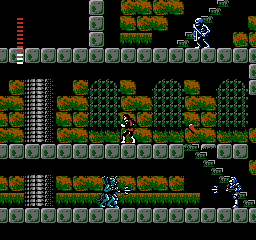 | 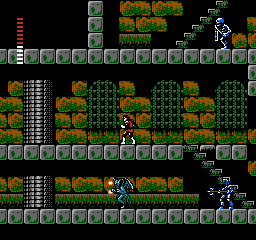 |
| Dracula II (FDS) | Castlevania II (NES) |
Stake Away
One of the Nerd’s big complaints is that the stake item seems like it should be a weapon, but when you go to use it in a fight, it does nothing. Not only that, you lose it after only one use. How is the player supposed to know that?!
Naturally, I decided to check the Japanese and English manuals for more info:
 |  |
| Japanese manual | English manual |
And here’s that text side-by-side for easy comparison:
| Japanese manual (basic translation) | English manual |
| Oak Stake Needed to obtain Dracula’s remains in the mansions. | The Oak Stake You’ll need the Oak Stake to collect Dracula’s corpse at the mansions. |
…So pretty much neither manual is very helpful when it comes to this item.
Tornado at Deborah Cliff
A big part of the Nerd’s rant is the part in Castlevania II where the player arrives at a giant dead-end of a cliff. Somehow the player is supposed to know that the only way to progress is to kneel down in front of the cliff for like 5 seconds… AND that you need to have the red crystal equipped at the same time. Only then will a tornado come and take you through the cliff.
 |
How was anyone supposed to know this, the Nerd asks. Well, there ARE various clues throughout the game, but some make little sense and some are lies, so it’s true that they’re not particularly helpful. It looks like one clue in particular is meant to tell the player about this cliff thing, though:
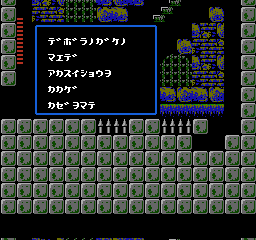 | 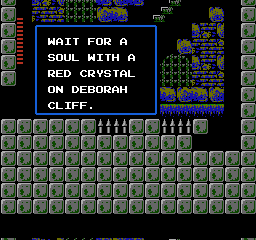 |
| Dracula II (FDS) | Castlevania II (NES) |
Side-by-side, here’s what the text in each version looks like:
| Japanese Version (basic translation) | English Version |
| In front of Deborah Cliff, hold high the red crystal and wait for the wind. | Wait for a soul with a red crystal on Deborah Cliff. |
What the…?! The Japanese version actually seems kind of helpful!
Somehow the English version got mucked up in a combination of ways, rendering the clue much less useful. Somehow “wind” was translated to “soul”. That and the ambiguous use of “with” makes it sound like some crystal-carrying soul will show up if you wait at the cliff. Or, if you read the “with” the other way, it simply tells you to wait at the cliff while you have the crystal in your inventory and/or equipped… but it doesn’t tell you to kneel. To be fair, the Japanese version doesn’t say to kneel either, but it does say to hold the item up above you, which is at least some sort of clue.
So it looks like this was indeed a case of a poor translation tarnishing the experience for NES players. This actually isn’t the only lackluster translation in Castlevania II – the game is riddled with poorly-written lines, including the infamous ”Graveyard Duck” line.
 |
Japanese fans were lucky – they didn’t have to put up with these same text issues.
Japanese Responses to this Episode
So, with all this in mind, I thought it might be neat to look at what some Japanese viewers have said about this particular AVGN episode! I find this the most fascinating of all, since they’re seeing these videos from a whole different viewpoint, you know? So let’s take a look at a few comments from Nico Nico:
Man, and the Disk System version has even WORSE pacing issues
1 and 3 are godly, 2 is crap
He actually finishes the entire game before claiming it’s a shitty game. Good on him!
Even back then this was a crappy game. It was pure crap
Don’t blame everything on the password system, there’s more crap to it than that
Damn, that’s one sluggish password system
There’s no way anyone would figure some of this out on their own
It’s much better than our Load Time Hell. Their audio also sounds kind of meh
During this time it was somewhat standard to buy a game AND its strategy guide together
I like the fact that he’s a fan yet also angry at it
I know this feeling all too well
This guy’s hilarious
The NES didn’t have a disk system
Don’t assume foreign gamers are as polite as Japanese gamers!
After watching it all, it’s actually a really solid review!
I like this audio
If you gave him the Disk System version he’d probably go insane from the load times
I dunno, I enjoyed it back in the day
Wasn’t there a hint, though? About carrying the red crystal and holding it up in prayer?
I really respect him for actually finishing the game first
The start of a great series!
Summary
Wow, looking back, this is actually a lot more than I expected to write. And the funny thing is, I’ve only scratched the surface of the game. I could go into much more detail about the differences between the games and showcase even more interesting tidbits of info… but since the Nerd re-reviews Castlevania II in a later episode, I think I’ll wait until then.
For now, if you’re interested in more Castlevania II fun, here are some other pages I recommend:
- The Cutting Room Floor’s Castlevania II page – info on unused content and more
- Castlevania II retranslation – by Castlevania super-fan Bisqwit
- Castlevania II remake
Oh, and one last thing: Please. Remember Bitter Memories in TRANSILVANIA!
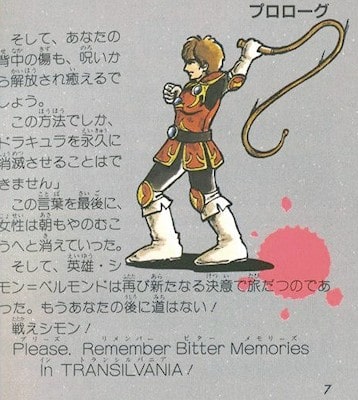 |
…Whatever that means.


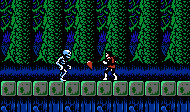

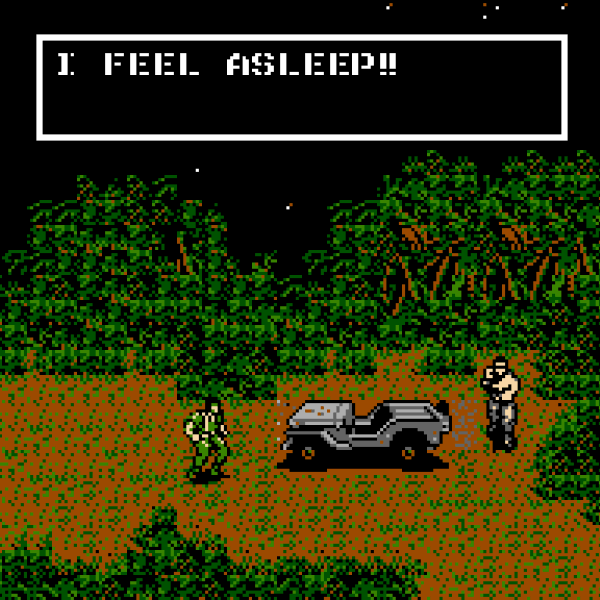
No Comments